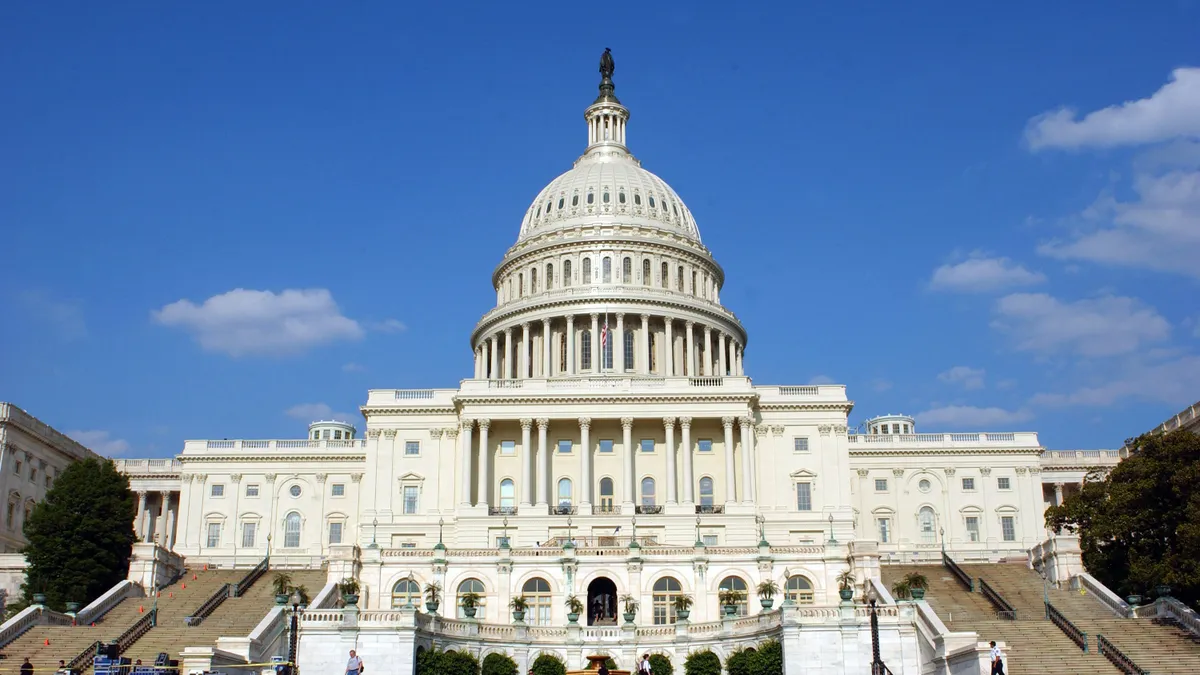Dive Brief:
- The Environmental Protection Agency’s proposal to cut carbon emissions from power plants depends on the use of unproven technologies, undermines states’ authority to determine their own energy resources and threatens to destabilize the electric grid, Republican lawmakers and several witnesses said Tuesday at a House Subcommittee on Environment, Manufacturing, & Critical Materials hearing.
- EPA in May proposed greenhouse gas emissions limits for coal-, gas- and oil-fired power plants, with initial requirements beginning in 2030 for coal-fired generators and in 2032 for gas-fired units.
- The commercial viability of compliance technologies such as carbon capture and sequestration, known as CCS, or hydrogen co-firing “is optimistic at best,” subcommittee Chairman Rep. Bill Johnson, R-Ohio, said at the hearing. EPA officials countered that the proposed rule allows generators sufficient lead time and flexibility to comply with emissions limits.
Dive Insight:
House Republicans heard from multiple witnesses on Tuesday who criticized EPA’s proposal for what Johnson called a lack of “technical and practical and feasibility.”
The proposal “requires stringent and unproven carbon dioxide emissions controls for coal-fired electric generating units to be implemented in unrealistic time frames,” David Glatt, director of the North Dakota Department of Environmental Quality, told lawmakers. And the plan would “usurp the authority and discretion” of the state agencies responsible for implementing environmental and energy policies, he said.
Coal-fired power plants provided 55% of North Dakota’s electricity generation in 2022, according to the U.S. Energy Information Administration. EPA’s proposal would require coal-fired plants operating past 2039 to install CCS that captures 90% of carbon emissions.
EPA’s proposed use of low-greenhouse gas hydrogen to meet plant emission limits “has not been adequately demonstrated, nor does it represent a reasonable extrapolation of what would be needed and available when necessary for compliance,” said Michelle Walker Owenby, director of the Division of Air Pollution Control at Tennessee’s Department of Environment and Conservation.
The power sector’s future hydrogen needs could be “over three times as much” as federal estimates, Owenby said. And EPA’s proposed use of CCS “will require unprecedented expansion of the pipeline system over the next 20 years” and ignores the fact that “landowner rights, impacts on disadvantaged communities and eminent domain are already controversial issues with respect to pipelines.”
Chris Parker, director of the Utah Department of Commerce’s Division of Public Utilities, told lawmakers the proposed greenhouse gas rule “would inject additional cost and uncertainty [into the power sector] ... by assuming the availability and affordability of unproven technologies.”
“If the rules are adopted, consumers will pay more for a less-reliable system,” Parker said. “Given increasing signs of trouble on the grid, regulators should help stabilize the system, not exacerbate its problems.”
Much of the U.S. bulk power system faces an elevated risk of blackouts in extreme winter weather, the North American Electric Reliability Corp. warned in a winter reliability assessment published this month. A key issue is the availability of natural gas supplies for generation and the operation of gas-fired power plants in extreme cold weather, NERC said.
EPA responded to the criticisms from the hearing in a statement, defending its “excellent track record” of designing and implementing regulations that reduce power sector emissions while preserving the reliability and affordability of electricity.
“The proposed standards and guidelines would provide owners and operators of power plants with ample lead time and substantial compliance flexibilities,” EPA said. And the plan puts states “at the forefront of developing compliance plans.”
“Our proposal recognizes state leadership and allows for a 2-year planning process to assist states in their efforts to work with their affected units,” EPA said.
Maryland Secretary of the Environment Serena McIlwain was the lone subcommittee witness in favor of EPA’s proposed rule.
“The current proposal ... features the much-needed flexibility for power plants so that both oil and gas plants have options,” McIlwain said. “There is built in consideration for retirement and the leeway needed for those who are planning to construct new facilities as well.”
The subcommittee hearing coincided with the Biden administration’s release of the Fifth National Climate Assessment, which concluded climate change is impacting every region of the country.
“The past 12 months have been the hottest ever recorded,” Rep. Frank Pallone, D-New Jersey, said. Conclusions from the national climate assessment “underscore the need for urgent action to combat the threat of climate change.”
EPA’s proposed rule would avoid up to 617 million metric tons of carbon dioxide through 2042, “and communities are projected to see up to $85 billion in net climate and health related benefits. Unfortunately, committee Republicans choose to ignore these significant benefits,” Pallone said. “And when it comes to reliability, the last few years have shown shown us that a widespread over-reliance on fossil fuels has left the power grid vulnerable — not common sense EPA rules.”















